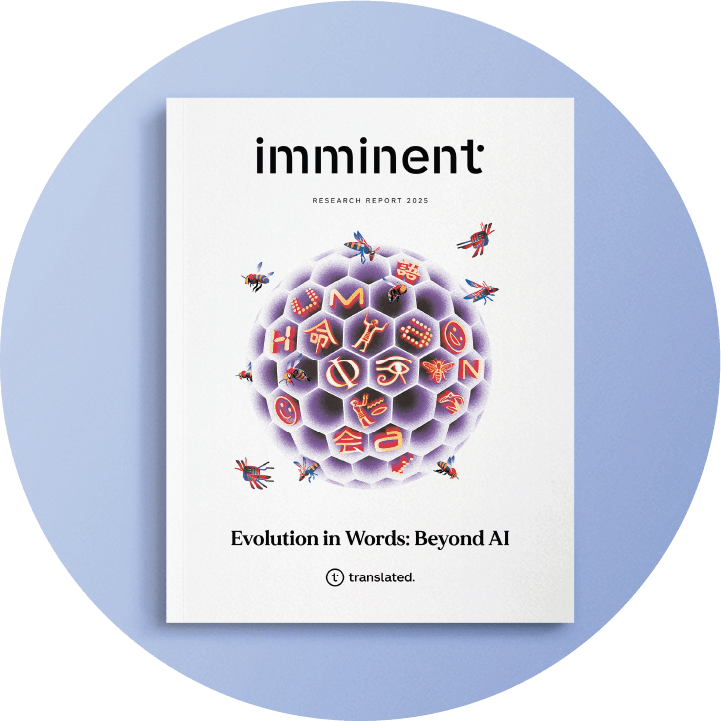Trends
Language is one of the fundamental factors in human evolution. Theories regarding the origins of language vary depending on different definitions of what language is and the availability of concrete evidence of its existence. Many scholars believe that the first members of the Homo genus, who crafted stone tools and had larger brains than their predecessors, must have possessed the ability to communicate using abstract signs to conceptualize the consequences of their actions. This assumption also serves as the basis for dating language, which according to a widespread school of thought could have arisen around 2.6 million years ago. Naturally, this is a subject that will attract further investigation. There is no doubt, though, that research into language is key to exploring some of the most specific characteristics of humanity: culture, the brain, and technology.
In fact, as cognitive abilities expanded, humans grew in number, and the agricultural and industrial revolutions unfolded, language itself underwent its own evolutionary phases. This also involved the introduction of new technologies, from writing to the dawn of artificial intelligence. These connections demonstrate that every great technological leap forward can only be truly understood if interpreted within the broader framework of human evolution. This perspective is crucial to formulating the right key questions, the ones that allow us to envisage the consequences of innovations. So then, what are the evolutionary consequences of artificial intelligence?
So then, what are the evolutionary consequences of artificial intelligence?
First and foremost, recent developments are challenging the idea of artificial intelligence as a technology capable of performing any cognitive task as well as or even better than a human. In reality, there’s no barrier to machines replicating human intelligence. It’s far more intriguing to envision machines that can do what humans can’t do so well. Starting from this premise, we can speculate that machines will develop capabilities and functions different from those of humans and which humans will not necessarily be able to replicate or even comprehend. This is essentially what happened with the advent of the pocket calculator: it might have seemed like a substitute for the human ability to make calculations in our heads, but in reality, it was a tool that allowed humans to perform processes for which our brains are not equipped. Even the humble pocket calculator proved to be a tool that expanded, rather than restricted, humans’ possibilities.
There is no physical law confining intelligence to the limits of human intelligence. This idea has far-reaching implications. Let us consider another example: robots’ humanoid forms were chosen so that they could seamlessly fit into factories that had been ergonomically designed for human shapes. This made it possible to take advantage of the production structures that had accommodated human labor, even while robots were being introduced: when non-humanoid robots will be made, though, factories will change, too. In short, an innovation first slots into the familiar socio-technical system but later redefines the boundaries of what is possible and enables further evolutionary leaps forward. Likewise, the introduction of intelligence that is different from human intelligence will drive the development of social and productive structures that are distinct from those explored to date. In such a context, everything is left to our imagination, but we do know at least one thing: if humans want to somehow imagine and govern the consequences of these radical innovations, they will have to be able to equip these super-intelligences with a super-alignment, to link this technology’s capabilities to the ethical and epistemological values that humans consider inalienable and promote their widespread adoption, fostering trust, minimizing conflicts, and enhancing cohesion in these processes.

Imminent Research Report 2025
A JOURNEY THROUGH LOCALIZATION, TECHNOLOGY, LANGUAGE, AND RESEARCH.
The ultimate resource for understanding AI's impact on human interaction. Written by a global community of multidisciplinary experts. Designed to help navigate the innovation leap driven by automatic, affordable, and reliable translation technology.
Secure your copy nowFrom this point of view and focusing specifically on the issues closest to the world of translation, alignment procedures must take some factual data into account.
Humans’ responsibility for knowledge production shifts in relation to the amount of information produced by machines. As humans increasingly focus on crafting prompts while machines produce most of the content in response, it’s conceivable that in a short time a majority of existing text will be machine-generated. All this has quite significant operational consequences and requires us to develop the pragmatic solutions needed to manage change. Let us suppose, for instance, that humans and their prompts account for 10% of knowledge production, while the remaining 90% is the prerogative of machine labor. In this scenario, we will define a text as a human product if at least 10% of it is human-generated. The resulting knowledge would then fall under human responsibility. Clearly, all this deserves in-depth exploration – in fact, the issue of responsibility in knowledge production will prove essential to the emerging cultural and economic landscape.
Cultural diversity in human knowledge is under considerable pressure, yet it must be safeguarded. Between 70% and 95% of the data used for training large language models are texts in English. Meta’s LLaMa 3, for example, is trained on 95% English content. Yet every culture has a different way of expressing and solving problems. The concern is that the culture of artificial intelligence will be fundamentally American. And with the o1 version, even the reasoning style will be American. None of this is without consequences. Even more so when working on translations. When translating, the first step is to place the original text in a conceptual space; from there, you then move on to rendering the text in the target language. The issue is that the conceptual space and reasoning style are both currently American. Translated tackled this phenomenon when we created Lara. We invested heavily to embed other cultures as frameworks for conceptual spaces.
However, the rate of new information production in languages other than English is relatively low. At this pace, it will take at least a thousand years for some languages to have enough data to bring machines to the level that English is at today. We could perhaps hope to accelerate the process by using audio recordings instead of written data. However, audio recordings are not currently archived. We’re culturally accustomed to preserving text, while we treat audio and video as ephemeral data. Video conferences are not archived. Even YouTube is tiny in comparison to the wealth of texts; it accounts for less than 1% of the web. In practice, the singularity in the world of translations will not be just one event, but a series of events. This is to be expected in such a complex evolutionary phenomenon: since there are great differences in the progress of different languages, some will arrive immediately, some in four years, and others in thirty years or more.
However, with artificial intelligence, we will not continue to think as we have done so far — precisely because this technology will do things that humans cannot do — it is possible to imagine paradigmatic transformations of the world of translations. In fact, languages remain exceptionally inefficient tools for conveying thought. An idea consists of reasoning, emotion, and concepts. When humans communicate ideas using language, we have to struggle to compress them for transmission and then decode them upon reception. As Claude Shannon has demonstrated, this process results in a loss of information.
In practice, the singularity in the world of translations will not be just one event, but a series of events. […] Since there are great differences in the progress of different languages, some will arrive immediately, some in four years, and others in thirty years or more.
Well, now it is possible to envision direct, brain-to-brain communication utilizing human-machine and even human-human interfaces that permit the immediate transfer of information, bypassing natural language altogether. There is no shortage of experiments involving animals, such as pigs and monkeys. Similarly, projects for electronic products to be implanted directly into the human brain are making headway. While technical and health challenges are significant, there is no shortage of emerging cognitive issues.
The challenge of designing direct connections between human brains is to avoid an information overload, which could render communication unmanageable. This is being addressed by contemplating the transfer of information no longer taking place through a human language but by encoding content in a less compressed space. In this type of project, traditional translations that flatten thought into language are replaced by multidimensional knowledge maps. New translations will then become knowledge maps, multiplying their value: at that point, it will be possible to tailor them to the recipient’s characteristics, key interests, education level, and cultural background. Eventually, there will be strong arguments justifying even highly invasive operations such as electronic interfaces between human brains configured as chips implanted in our skulls.
We also have to consider that the process of improving the communication that translations can facilitate is not the only historical dynamic at play. Humans often seek to maintain their distinct identities: they want to form groups and define themselves in contrast to others. Humans frequently shift the way they communicate depending on the group they’re interacting with. All this implies a complex web of phenomena that remains the backdrop against which any technological innovation unfolds.

Marco Trombetti
Founder and Ceo of Translated
Marco Trombetti is a computer scientist, serial entrepreneur and investor. In 1999, together with his wife Isabelle Andrieu, he co-founded Translated, a translation service that pioneered the use of artificial intelligence to help professional translators. With the profits from these ventures, Marco co-founded Pi Campus, a venture capital firm that invests in early-stage technology startups, mostly in the AI field.
